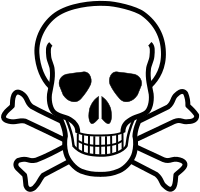Thomas Day (pirate)
Thomas Day (fl 1697, first name occasionally John) was a pirate and privateer active off the American east coast. He is known for being one cause of increasing tensions between the Governors of Maryland and Pennsylvania.
History
Early in 1697 Captain Ball of the ship Kent from Bristol died en route to the Americas and was succeeded by the ship’s mate, Thomas Day. He put into port at the Province of South Carolina, condemning the ship and selling off its cargo of indigo and sugar.[1] With the proceeds he purchased a brigantine and sailed north with intentions of becoming a privateer. In Pennsylvania he resupplied and was granted a privateering commission by Governor William Markham of Pennsylvania. A French privateer had recently taken several vessels nearby and when Day offered to patrol the region in exchange for men and supplies, Markham accepted. Robert Quary spoke in his favor: “Sir (I said) this thing could not have happened at a better time, for here is Captain Day who has a gang of brisk fellows. Add thirty or forty to them from the lower counties, and give Day a commission to command them.”[2]
Maryland officials were angry that some of Henry Every’s pirates crew were still at large in Pennsylvania, where they paraded openly and were never seriously detained. They suspected that with such a large crew, Day’s true intention was to sail for the Red Sea on the Pirate Round route.[3] Markham originally replied that “that Day was down the river out of his reach, and that they had not force in the province to command him.”[2] Maryland Governor Francis Nicholson ordered Captain Josiah Daniell of the Royal Navy warship HMS Prince of Orange to dispatch two of his lieutenants and sixty men to apprehend Day[3], but Pennsylvania authorities challenged them and refused to let them proceed, now citing Day’s commission.[2]
Nicholson and Markham fired angry letters back and forth, writing to the Council of Trade and Plantations[3] and to Pennsylvania’s proprietor William Penn. Daniell and Nicholson accused Markham of not only harboring pirates but profiting from their activities[4], which he vehemently denied: “Governor Nicholson alleges that I got great matters by Day's commission, but I solemnly declare that I had not the value of a farthing for it, and gave it only in view of the common danger.”[2]
After provisioning in Pennsylvania and obtaining his commission, Day took his brigantine to the Caribbean, sailing to Curacao and then across the Atlantic to Holland. From there he may have sold his brigantine and sailed to Holland on his own, or may have remained in command of it while he sailed to Holland.[2]
Nicholson himself would continue his anti-piracy crusade, personally boarding the HMS Shoreham in 1700 when it sailed against pirate Louis Guittar.[5]
See also
- Admiralty court – Nicholson pushed for establishment of these in the American Colonies to try pirates locally, a move opposed by William Penn.
- Jacob Leisler and Benjamin Fletcher – two other colonial Governors who, like Markham, were frequently accused of collaborating with pirates.
References
- ↑ Burgess, Douglas R. (2008). The Pirates' Pact: The Secret Alliances Between History's Most Notorious Buccaneers and Colonial America. New York: McGraw Hill Professional. pp. 159–164. ISBN 9780071643368. Retrieved 11 October 2017.
- 1 2 3 4 5 Fortescue, J W (1905). Calendar of State Papers Colonial, America and West Indies | British History Online (Vol 16 ed.). London: His Majesty's Stationery Office. pp. 19–53. Retrieved 11 October 2017.
- 1 2 3 Fortescue, J W (1904). Calendar of State Papers Colonial, America and West Indies | British History Online (Vol 15 ed.). London: His Majesty's Stationery Office. pp. 560–635. Retrieved 11 October 2017.
- ↑ Rhoden, Nancy L. (2014). English Atlantics Revisited: Essays Honouring Ian K. Steele. Quebec ON: McGill-Queen's Press - MQUP. pp. 68–73. ISBN 9780773560406. Retrieved 11 October 2017.
- ↑ "The bloodiest pirate battle to hit these waters". Virginian-Pilot. 28 January 2007. Retrieved 21 June 2017.
